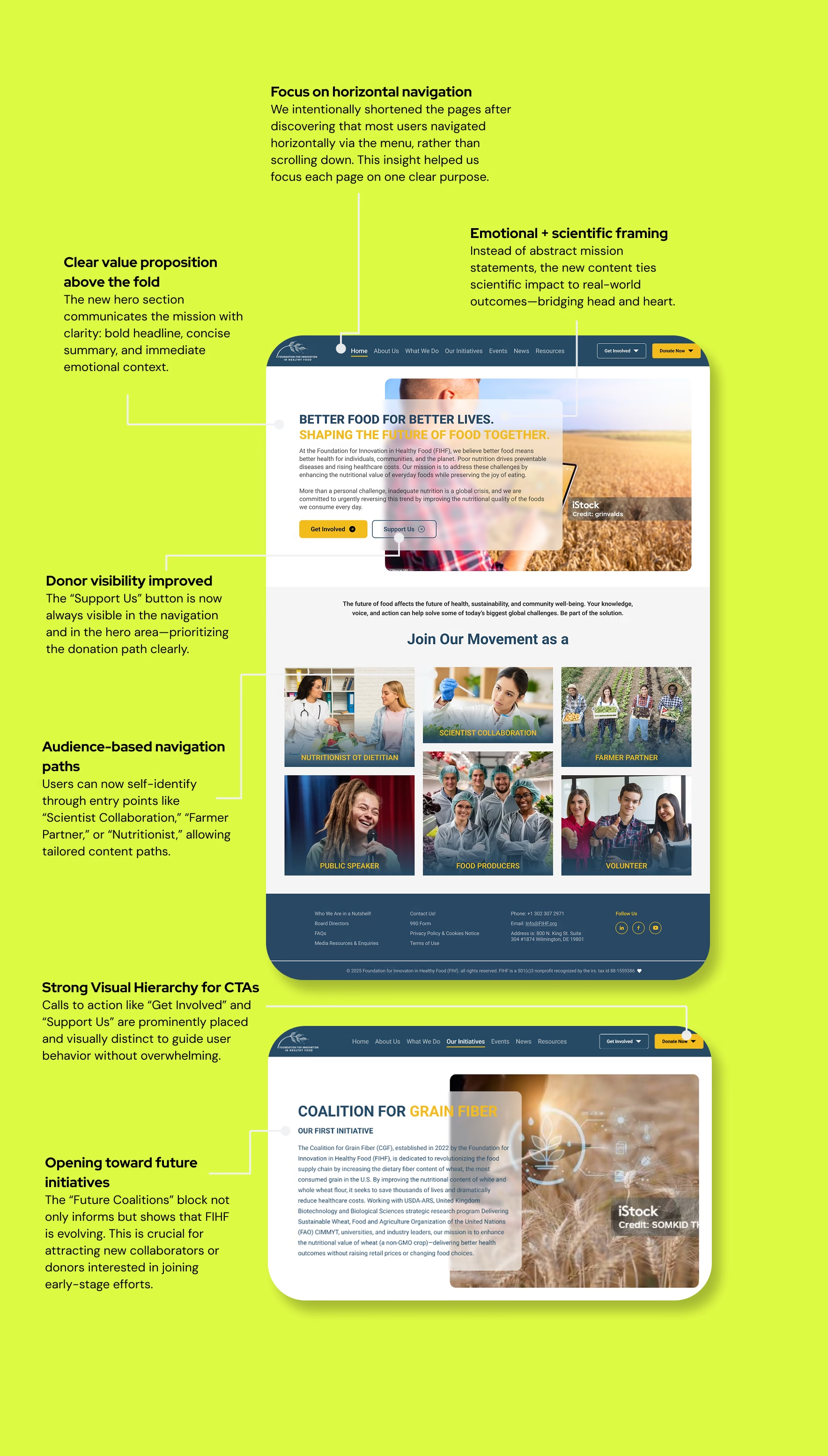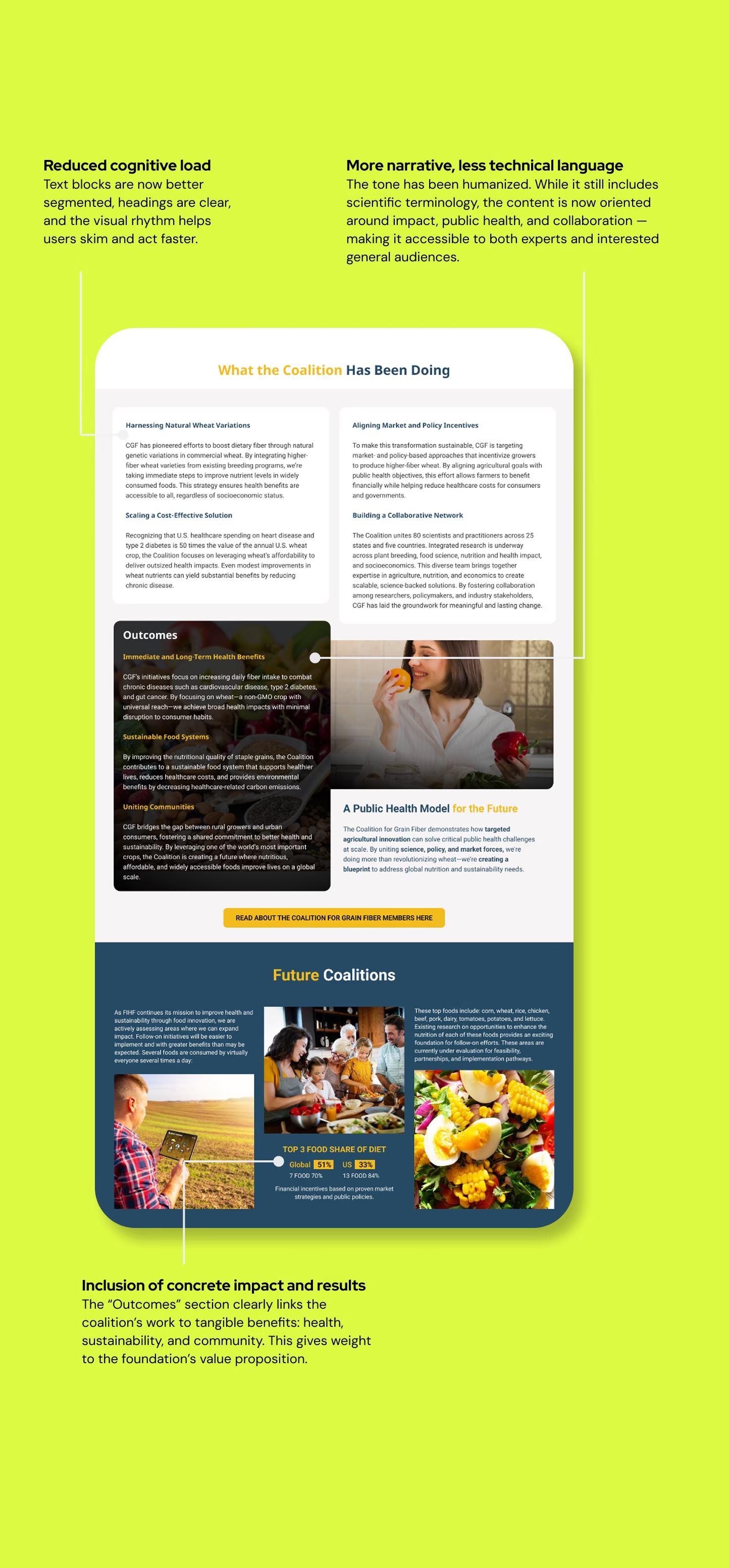The biggest challenge wasn’t visual—it was clarity. FIHF needed to show why their work matters to funders, scientists, and everyday people alike. I led a research-first process to refocus messaging, segment navigation, and turn vague CTAs into real pathways for action.
Scroll for a research-first story that shaped a complete redesign. Or jump to the solution here.
UX Consultant –
Research, Copy & Strategy.
1 UX Researcher,
1 UI Designer & Dev Team
March 2025 – May 2025
(8 weeks)
Figma, Hotjar, Semrush, GA4
FIHF (Foundation for Innovation in Healthy Food) is a non-profit aiming to improve the nutritional value of food without requiring changes in consumer habits. The foundation collaborates with scientists, farmers, and food industry leaders.
Despite its innovative mission, its website wasn’t effectively communicating the value of the foundation to its highly diverse audience:
To go beyond assumptions and uncover real user needs, I combined:
The website lacks clear indicators of where users are or how far along they are in a process.
The language used is overly technical and not easily understood by all target audiences (e.g., farmers, general public).
There are no shortcuts or personalized routes for different users (e.g., scientists, farmers, donors).
Navigation lacks clear ways to go back or undo actions.
Some links and CTAs appear in inconsistent formats, leading to confusion.
Forms do not provide real-time feedback or mark required fields clearly.
Main sections of the website aren’t visually highlighted, requiring users to remember where to find info.
The site looks clean, but feels cold and impersonal due to overuse of stock imagery.
There is no Help or FAQ section to guide new users.
From the interviews, I extracted the main needs across audiences:
Over-focus on the present (e.g., CGF) made the foundation appear small or static.
Recommended a segmented architecture with landing flows and navigation based on persona. Each main stakeholder group should have tailored homepages or sections.
Need for human proof: photos, testimonials, named collaborators, and visible impact stories. The current site felt hypothetical and abstract, especially for potential partners.
There’s potential to build retention here through clearer paths for early-career collaborators.
Requested a dedicated “For Farmers” page showing profitability, success stories, and how their work contributes.
A more personal and transparent contact method, with photos and names of FIHF staff. This would build credibility.

Compared FIHF to FAO, WFP, Feeding America, Better Food Foundation, etc., uncovering gaps in storytelling, navigation structure, and donation flow.

Explained what FIHF does, who it serves, and why it matters — all above the fold.
Segmented navigation by role (e.g., Researchers, Farmers, Donors) to help users self-identify and find relevant content faster.
Reframed CGF as “the first of many initiatives” and introduced space to showcase other projects and future plans.
Elevated scientific partners, real results, and visual credibility markers to boost user confidence.
Swapped stock visuals for real people, real quotes, and real stories — making the foundation feel human and relatable.
Redesigned calls to action with specific outcomes and made them visible in menu, body and footer.
Planned to highlight key numbers, outcomes, and impact KPIs across pages.
Created “Join as a…” flows to give each user group a role, a benefit, and a reason to act.
Balanced visual clarity with emotional storytelling and made information scannable.






Onboarding redesign focused on increasing free to trial conversion, reducing drop-off, and enhancing perceived value. By incorporating personalisation, social proof, and interaction variety, the new flow aims to drive higher activation and subscription rates.